This guide includes a complete SEO content writing checklist you can download, print, and use to keep track of the key elements necessary when optimizing your content for search engines like Google, Yahoo, and Bing.
Download the free SEO writing checklist in PDF format using the link below, then read through the SEO content writing instructions on this page to understand how to use it correctly when optimizing your articles and blog posts.
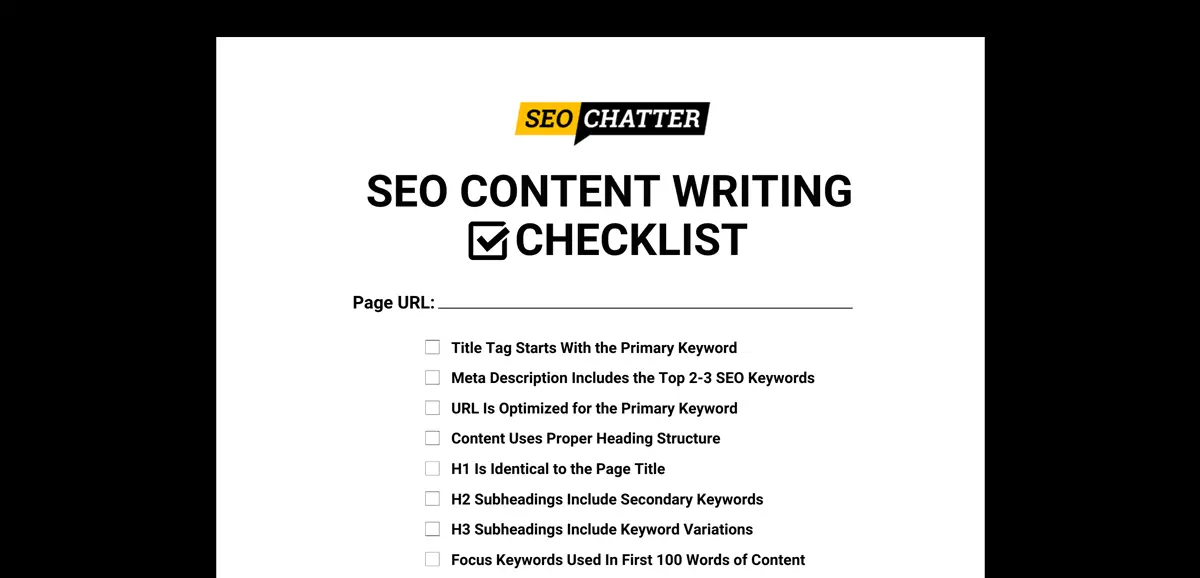
Download the SEO Content Writing PDF Checklist
SEO Content Writing Checklist Items
1. Title Tag Starts With the Primary Keyword
The fundamental starting point for this SEO content writing checklist is to optimize your page’s title tag. Title tags are essential elements of SEO writing, telling both search engines and search users what your content is about. Therefore, knowing how to optimize the title tags correctly for on-page SEO.
Placing your primary keyword at the very beginning of these title tags gives search engines like Google a greater understanding of your post’s main subject, helping you to rank better for relevant search terms.
What’s more, optimized title tags also catch users’ attention in the search engine results pages (SERPs), giving them a clear idea of whether your content meets their search intent and ultimately bolstering your click-through rates (CTR).
2. Meta Description Includes the Top 2-3 SEO Keywords
Meta descriptions provide a brief summary of your page’s content that appears beneath your page title in search results.
Here, you should check that your primary keyword is featured towards the start of your meta description, with one or two secondary keywords naturally incorporated throughout the text. This helps search engines understand the relevance of your page to a user’s query.
Keyword-optimized meta descriptions also have the added advantage of helping users learn more about your content to make an informed decision about whether it meets their needs. This factor can make a huge difference in boosting click-throughs and reducing bounce rates for your pages.
3. URL Is Optimized for the Primary Keyword
Along with your title tag and meta description, search engines also use the URL of your content to understand its context and relevance to search queries. Therefore, it’s important to include your primary SEO keyword in the page’s URL.
Using the primary keyword as the URL also makes it short, and easy to remember, making the URL structure both SEO and user-friendly.
4. Content Uses Proper Heading Structure
Header tags are another essential tool for delivering optimum user experiences. HTML headings range from H1 to H6 as a way to organize and structure your content, making it easier for readers to navigate through your content and find the precise information they need and for search engine crawlers to understand the main topics and subtopics on the page.
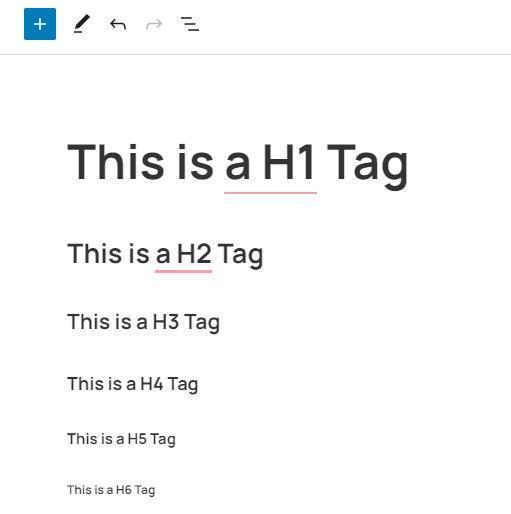
We recommend reading our guide to optimizing header tags for SEO to learn how to deploy them effectively for higher rankings in the SERPs, but if you don’t have time for that right now, here’s a basic overview:
- H1: Use this once for the visible page title.
- H2: Use this tag to divide your content into its main sections
- H3: Use this tag to divide your H2 sections into subsections.
- H4-H6: Use these to divide sections into further subtopics (e.g., nesting H4s under H3s, H5s under H4s, and H6 tags under H5s) when necessary.
5. H1 Is Identical to the Page Title
Next up on this free SEO content writing checklist is to ensure that your H1 tag matches your title tag word-for-word. This is a best practice of on-page SEO.
Maintaining consistency between these two tags strengthens the understanding of your content for search engines and readers alike, leaving absolutely no doubt about its primary subject and relevance to search intent. Read our guide on the best practices for H1 tag optimization to learn more.
6. H2 Subheading Include Secondary Keywords
Incorporating a mix of primary and secondary keywords into header tags helps to improve your page’s organic search visibility by telling search engines about all the topics covered within the content.
Ultimately, this helps you to expand your keyword coverage and rank for more long-tail keywords relating to your subject. It can also help with usability by ensuring your readers find the information they’re looking for as quickly as possible.
An SEO content writing best practice to follow is to include the primary keyword in the first and last H2 tags on the page, with 2-3 secondary keywords placed in other H2s where they naturally fit. That way, you have good on-page SEO coverage for your most important keywords without under or over-optimization.
7. H3 Subheadings Include Keyword Variations
If you haven’t already done so, use a tool like Semrush to find variations of your target keyword and weave a small handful of them into your H3 tags. See image below.
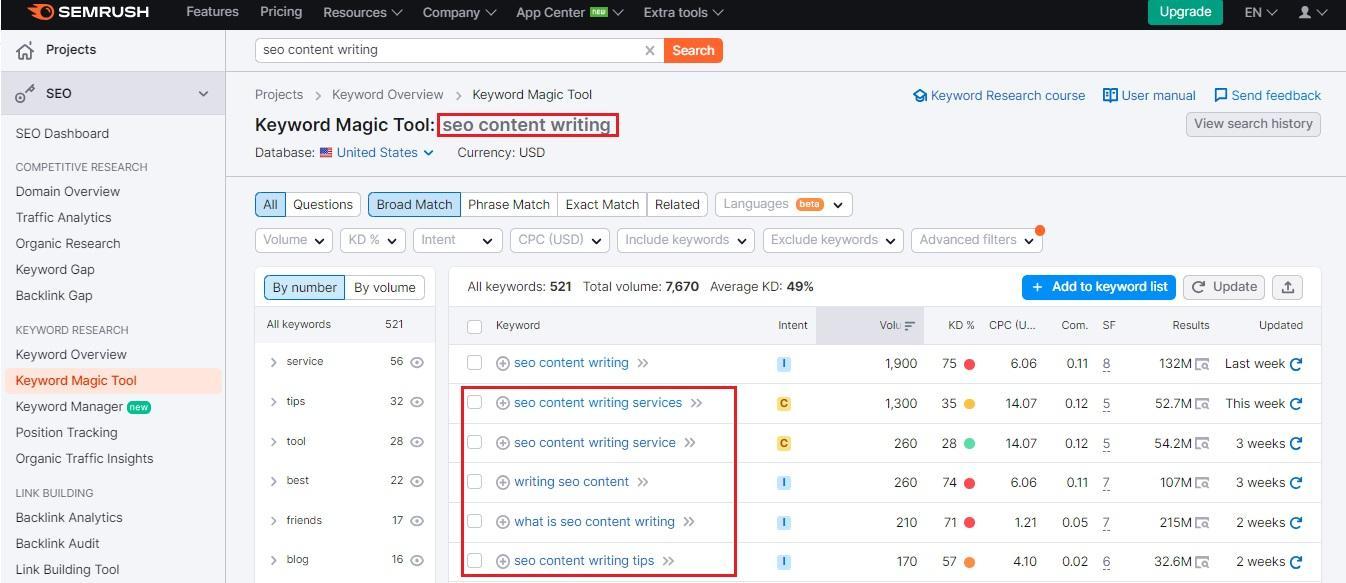
This content writing optimization technique helps search engines understand the diverse topics covered within your article, improving its visibility and relevance for a range of semantic keywords.
8. Focus Keywords Used In the First 100 Words of Content
Search engines generally prioritize the beginning of the content to understand its relevance for specific queries. By strategically incorporating your target keywords early on the page, you provide yet another signal to search engines about the topical relevance of your content.
As you can imagine, using focus keywords in the initial content section (i.e., introduction) improves the user experience by providing a clear indication of what your content is about.
Here, one best practice to follow for SEO writing is to include your primary keyword in the first sentence naturally, or at the very least, within the first paragraph. From there, you can sprinkle your secondary keywords into the rest of your page’s introduction so they read naturally.
9. Focus Keywords Used In the Last 100 Words
Incorporating your focus keywords in the closing section of the page can provide additional reinforcement and context to the overall topic. Therefore, you should optimize well to boost keyword relevance for your SEO content.
To do this, use the same rules that applied to your introduction:
- Your primary keyword should be as close to the start of the last 100 words on the page as possible, in either the first sentence or the first paragraph.
- Supporting keywords are placed after the primary keyword in the summary text.
- Ensure that each SEO keyword is seamlessly integrated into the content without compromising the flow and natural readability of your article.
10. All SEO Keywords Used Throughout the Body Text
As you move through your SEO writing checklist to the body of your content, the most important thing to look for is how your keywords are incorporated and how often in the written copy on the page.
Forcing your primary keyword into every other paragraph to increase keyword density can negatively impact the readability of your content, especially when a different word or phrase sounds more natural. This practice is known as keyword stuffing, a black hat SEO technique that’s more likely to get your content demoted rather than promoted in search results.
As explained in our other post on how many keywords per page for SEO, the number of times you use a keyword in the body text depends on the length of the content.
For example, a 500-word blog post can easily be optimized for two or three keywords, but trying to fit five or six keywords into a short article like that will likely sound unnatural. However, focusing on five or six keywords in a 2,000-word blog post is a common practice and you can spread out the usage of those phrases so the content sounds natural.
A good rule of thumb for SEO content writing is to use 1-2 keywords for every 100 words of text. This results in a keyword density of around 1-2% which is considered to be a good percentage for on-page SEO without keyword stuffing.
One easy way to do this is to use an SEO tool such as RankMath or Yoast SEO, which will automatically calculate your keyword density and let you know if you’re over (or under) doing it.
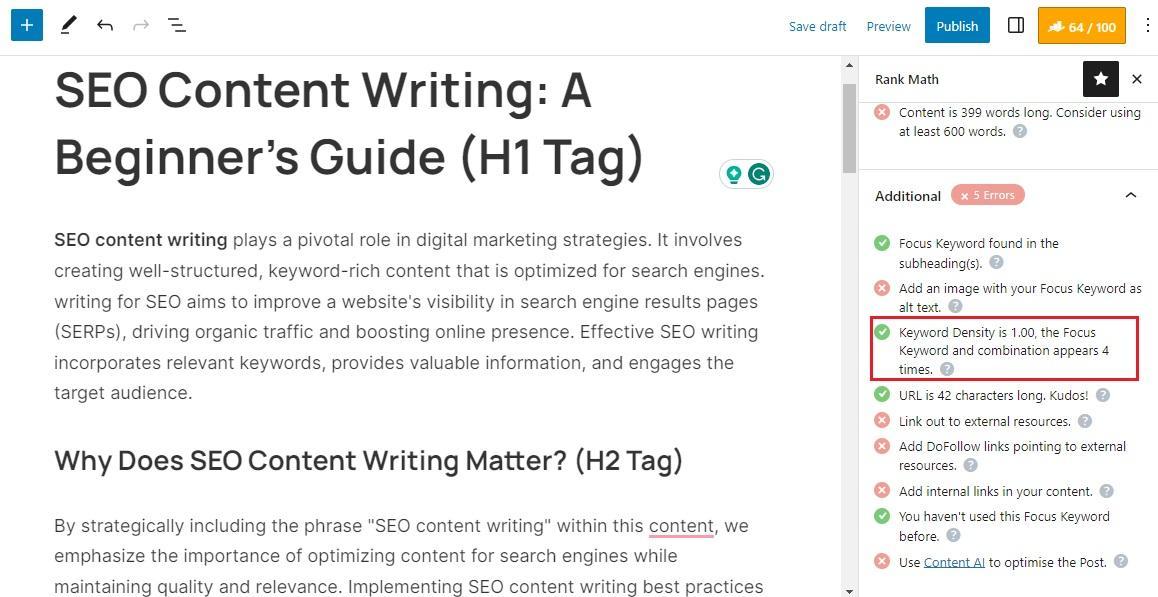
11. Content Meets User Search Intent
When users search on Google, Yahoo, and Bing, they have a specific intent or goal in mind. Aligning your content with that intent increases the likelihood of attracting relevant traffic and satisfying user needs.
This is where an SEO tool like Semrush comes in handy, as it gives you basic insights into the type of intent users have for specific search terms, whether that’s making a purchase or simply finding the answer to a question. As you can see in the image below, the search phrase “SEO content writing service” has a commercial intent. Therefore, the content you create should match that intent to rank high in the SERPs and get clicks.
However, this step alone is rarely enough to rank in the top positions on Google. To ensure that you’re meeting search intent as closely as possible, examine the top-ranking pages for your target keywords.
The fact that these pages are at the top of search results shows that Google considers them highly relevant to those keywords’ search intent. By analyzing the content, format, and level of detail of those pages, you can get a better idea of what your users are looking for. As a result, you can write the best type of SEO content that’s aligned with user search intent and what Google’s algorithm is rewarding for high rankings without having to guess.
12. Content Has the Correct Word Count
Despite what you may have heard, there is no single “best word count for SEO.” This has been confirmed by Google in their August 2022 Helpful Content Update.

Still, that doesn’t mean that word count doesn’t matter at all. Aiming for a specific number of words with no thought as to whether your topic actually warrants such a lengthy post can lead to you padding out your articles with unnecessary “fluff” and information that is only vaguely relevant to the subject.
Instead, consider how many words you need to cover the topic comprehensively and fulfill the intent of your content. A good way to do that is to analyze the average word count for the top 10 ranking results in Google. Then, write an article around that average length.
13. Paragraphs Are Short (Between 2-3 Sentences)
Short paragraphs enhance readability and improve the overall user experience. Here, you should check that each paragraph contains no more than 2-3 sentences, with each paragraph discussing no more than one key point or idea.
This SEO writing method helps readers easily digest information and follow the flow of your content. This improves user experience and can impact rankings in the SERPs.
14. Content Includes Relevant Entities for Semantic SEO
Entities refer to specific people, places, organizations, and things that are relevant to your content’s topic. Entities are a part of semantic SEO which is becoming a more important ranking factor for Google which is a semantic search engine.
By incorporating closely related entities in the content, you enhance the context and meaning of your article, making it more understandable to search engine crawlers and expanding the total number of search terms it can rank for.
The easiest way to cross this item off your SEO content writing checklist is to create a basic list of all relevant key entities relating to your topic. You can then go back through your content to embed each entity in a natural way to boost topical relevance for semantic SEO. See our related guide with a list of free LSI keyword generators for keyword research.
15. Content Is Optimized for Featured Snippets
Featured Snippets are concise summaries that appear at the top of search engine results, providing users with quick information or answers to questions. Ranking in the Featured Snippet positions can drive more organic traffic to your pages and boost brand awareness.
Here, you can use Semrush or another SEO tool such as Ahrefs to find question-based long-tail keywords relating to your keyword to incorporate on the page to capture more Featured Snippets.
You can also find questions to target in Google’s People Also Asked section that appears on the SERP for your query. See the example image below.

To win one of these Featured Snippets, format your content in a way that Google is rewarding, such as a short paragraph, table, or list. Then, add the keyword search phrase as an H2 high up on the page with the answer directly below it in the correct format. You should also check that you’ve used the appropriate schema markup, which will be discussed later in this SEO writing checklist.
16. Content Includes E-E-A-T Signals
E-E-A-T stands for Experience, Expertise, Authoritativeness, and Trustworthiness, which is used by Google’s Quality Raters to evaluate the quality of search results.
Demonstrating E-E-A-T helps you build your reputation as a trusted source of information on your topics, which can boost your site’s credibility in the eyes of Google, leading to better search engine rankings.
How you do this will depend on your niche and topic, though it generally involves proving that you really do know your subject matter by highlighting your personal experiences, using videos and photos to demonstrate that you’ve actually used the products, tools, or strategies you’re talking about, and including your credentials in an author bio to showcase your expertise and legitimacy.
See our related guide on How to Optimize for Google’s E-E-A-T to Improve SEO for a complete overview of everything you can do to enhance the E-E-A-T signals for your SEO content.
17. Content Include at Least 3-5 Internal Links for SEO
Internal links help search engines discover and navigate your site, improving its overall visibility and ranking potential while also providing added value to readers in the form of additional resources relating to their query.
As you work through this free SEO content writing checklist, ensure that your links are:
- Highly relevant to the content you’re linking from.
- Optimized for keywords relevant to the linked-to page.
- Placed naturally throughout your content.
This guide is also helpful: Internal Linking Best Practices (SEO Structure & Strategies)
18. Content Includes External Links to High-Quality Sites
By including external links to reputable and authoritative sources, you enhance the credibility and trustworthiness of your content. External links also provide additional resources and references for users, enriching their experience and providing further context.
Here, you need to check that you’re only linking to credible, high-authority websites that are relevant to the subject and genuinely help your readers. A good way to do that is to analyze the Domain Authority for the site you want to link to as well as the Page Authority for the target URL. If both of those SEO metrics are high, then it indicates a trustworthy and credible resource to link out to in your content.
19. Content Includes Keyword-Optimized Images
Optimized images can attract organic traffic through image searches on Google Images and Bing Images and enhance the overall on-page SEO signals for search engine crawlers.
Here, you should include primary, secondary, and variation keywords in all of the following:
- Image file name
- ALT text
- Captions
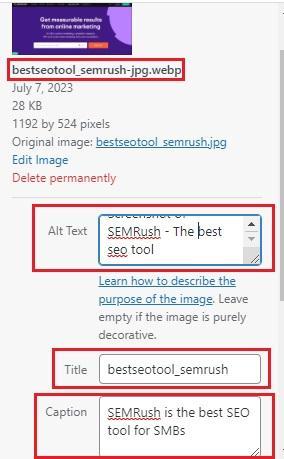
20. Proper Schema Markup Is Used for Rich Snippets
The final item in this SEO content writing checklist is to ensure you’re using appropriate schema markup to win prime real estate in search results for rich snippets. This feature enables your content to include enhanced listing elements in the SERPs like review star ratings, recipe instructions, business addresses, videos, etc, and allows the page to be featured in Google’s Search elements like carousels, images, and non-textual elements.
Schema is a form of structured data that helps search engines understand the context of your content and its relationship to people, places, themes, and organizations. You can read our free guide on How to Add Schema Markup to Website for SEO to get step-by-step instructions on setting it up properly.
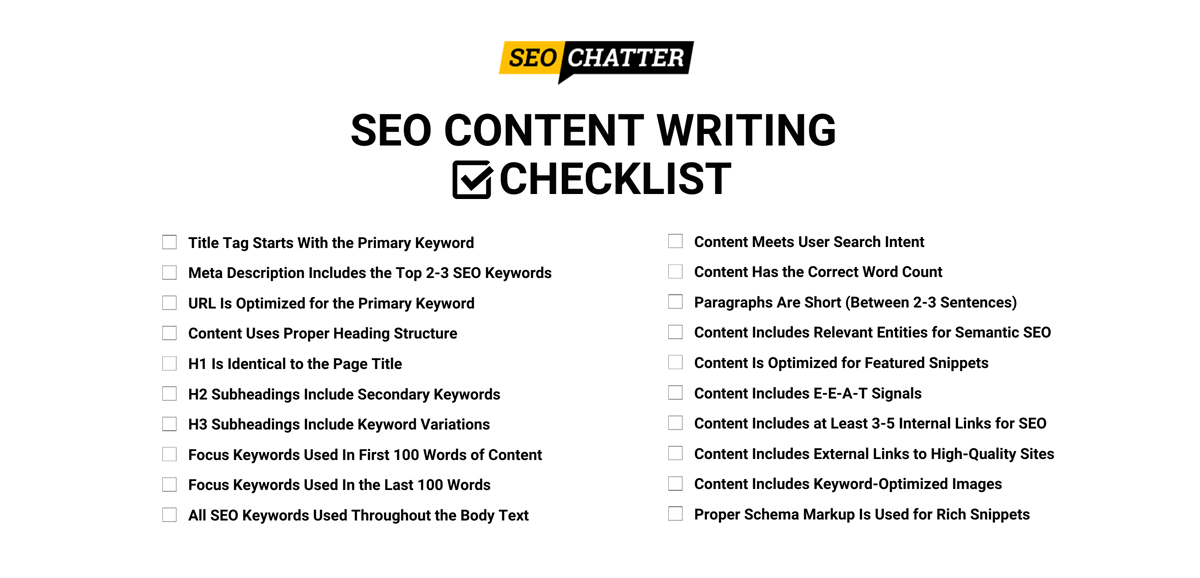
Download a Free SEO Writing Checklist
The SEO writing checklist outlined on this page is available in PDF format for you to copy, download, and use to mark off each website optimization task as you complete it:
Learn More About SEO Content Writing
The links below explain more about SEO content writing. Use these resources to expand your knowledge on the subject.
- What Is SEO Writing?
- What Is SEO Content?
- SEO Content Writing Tips
- SEO Checklist for Blog Posts
- SEO Writing for Beginners
- How to Write SEO Friendly Content
SEO Content Writing Checklist Summary
We hope this free SEO content writing checklist makes a great addition to your search engine optimization toolkit.
As you discovered, this SEO writing checklist includes a list of the most important steps to perform when optimizing your articles and blog posts for search engines. This downloadable SEO content writing cheatsheet will ensure you never miss out on the vital factors that can be optimized for SEO to increase the organic rankings and visibility of your pages in search engines like Google, Yahoo, and Bing.

SEO Chatter is dedicated to teaching the fundamentals of search engine marketing to help marketers understand how to increase organic website traffic and improve search engine rankings.

